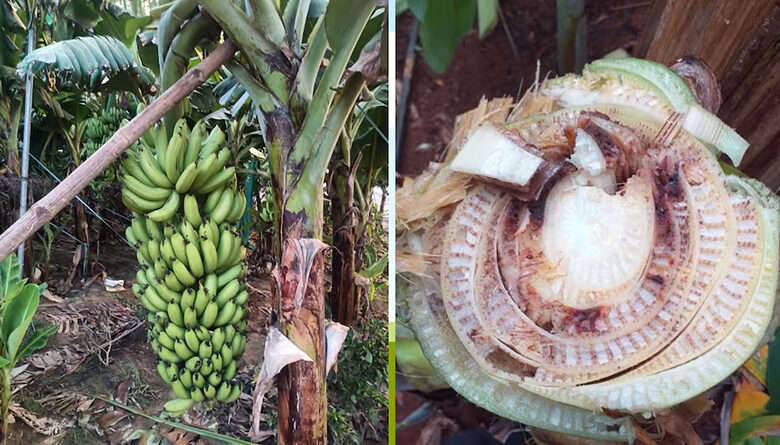
- Banana crops are at risk of destruction due to fungal Fusarium infection
- The bioagent developed by the institute is highly effective in controlling the disease
Raksha-Rajneeti Network
Lucknow : In a major boost for banana farmers, the Central Institute for Subtropical Horticulture (CISH), Lucknow, affiliated to the Indian Council of Agricultural Research, and the Regional Research Center Lucknow, affiliated to the Central Salinity Research Institute, Karnal, have discovered an effective treatment for a critical issue affecting banana crops.
Fusarium Wilt disease is highly detrimental to banana crops, with severe infections leading to crop destruction. In recent years, this fungal disease has affected several banana-producing regions of Uttar Pradesh. Notably, in 2021, the Sohawal block of Ayodhya, renowned for banana cultivation, witnessed a widespread outbreak.
Similarly, the Fusarium Wilt disease (TR4) severely impacted banana crops in key production areas such as Maharajganj, Sant Kabir Nagar, Ambedkar Nagar, and Kushinagar districts. Recent surveys also confirmed widespread infection in Lakhimpur and Bahraich districts.
The disease infects the inner part of the banana stem, causing it to turn brown or black, instead of the usual creamy color, indicating the plant’s deteriorating health.
The Central Institute for Subtropical Horticulture (CISH), Lucknow, affiliated to the Indian Council of Agricultural Research, and the Regional Research Center Lucknow, affiliated to the Central Salinity Research Institute, Karnal, together discovered its treatment.
With the patent, now farmers are also being encouraged to use it through Krishi Vigyan Kendra Ayodhya. The results have also been good. The farmers of Sohawal who had stopped, or reduced banana planting, have resumed plantations.
It is noteworthy that under the leadership of Dr. T. Damodaran, a management protocol was developed using bioagent, ICAR Fusikont (Triochoderma based formulation) and bio-vaccination of tissue culture plants for prevention of the disease. The product Fusikont was a 9(3B) registered formulation for banana wilt management. It has also been commercialized by ICAR for production and supply in sufficient quantities to meet the demands of farmers.
According to Dr. T. Damodaran, Director of the Institute, the Fusikont bioagent developed by the Institute is fully water-soluble. To prevent Fusarium Wilt disease, farmers are advised to mix one kilogram of Fusikont with 100 liters of water, and apply one liter of this solution to the roots of banana plants at intervals of 3, 5, 9, and 12 months after transplantation.
However, if symptoms of the disease persist in the crop, farmers need to mix 3 kilograms of Fusikont with 500 grams of jaggery in 100 liters of water. After allowing it to sit for two days, they have to apply one to two liters of the mixture to the roots of the plants at 3, 5, 9, and 12 months post-planting for effective disease control.
He also advised banana-producing farmers to regularly change their crop rotation. The likelihood of infection from Fusarium Wilt disease is lower in the first year’s crop. However, the risk increases if the second crop is derived from the same sapling.
It is recommended to plant crops such as paddy, wheat, onion, and garlic after banana before replanting bananas. This practice not only helps maintain soil balance but also reduces the risk of disease infection.
According to the institute’s head scientist, P.K. Shukla, when a crop becomes widely popular in non-traditional areas, it increases the risk of disease infections. This has been the case with bananas.
Recently, during an inspection of 144 banana orchards across Amethi, Barabanki, Ayodhya, Gorakhpur, Maharajganj, and Sant Kabir Nagar districts, Dr. P.K. Shukla discovered several species of plant-parasitic nematodes in the root zones of banana plants. These nematodes not only directly reduce the crop’s yield potential but also make it more susceptible to fungal diseases. Although their population was found to be below the economic damage threshold, it is advisable for banana farmers to manage their numbers through effective crop rotation and by planting tissue culture plants.
Yogi govt promotes banana cultivation due to its economic and nutritional significance
The Yogi government is actively promoting banana cultivation, recognizing its economic and nutritional value. In addition to providing a per-hectare subsidy for banana farming, the government offers substantial support for installing drip or sprinkler systems and solar pumps.
Furthermore, banana has been designated as the ‘One District, One Product’ for Kushinagar, leading farmers to not only harvest bananas but also produce various by-products. As a result, there has been a significant increase in the popularity of banana cultivation in Uttar Pradesh.
Area of banana cultivation in Uttar Pradesh is approximately 70,000 hectares
Currently, the area under banana cultivation in Uttar Pradesh is approximately 70,000 hectares, yielding over 3.172 lakh metric tonnes, with a production rate of about 45.73 metric tonnes per hectare.
Key districts contributing to this cultivation include Kushinagar, Gorakhpur, Deoria, Basti, Maharajganj, Ayodhya, Bahraich, Ambedkarnagar, Barabanki, Pratapgarh, and Kaushambi. Additionally, Sitapur and Lakhimpur districts also have a significant area dedicated to banana crops.





